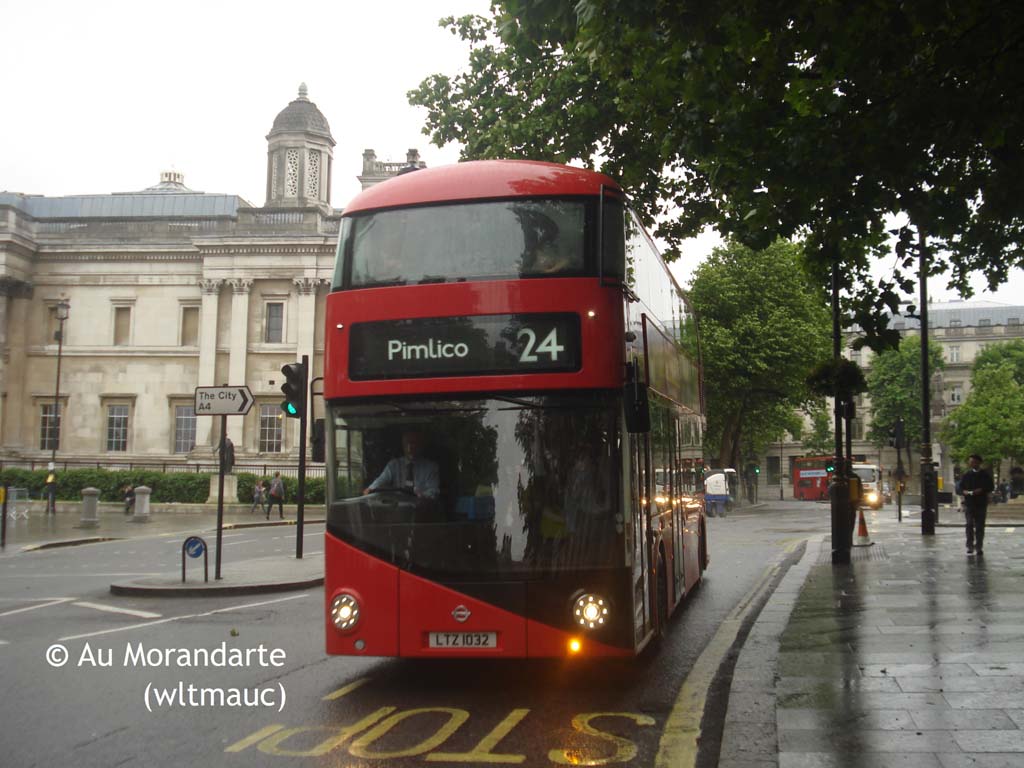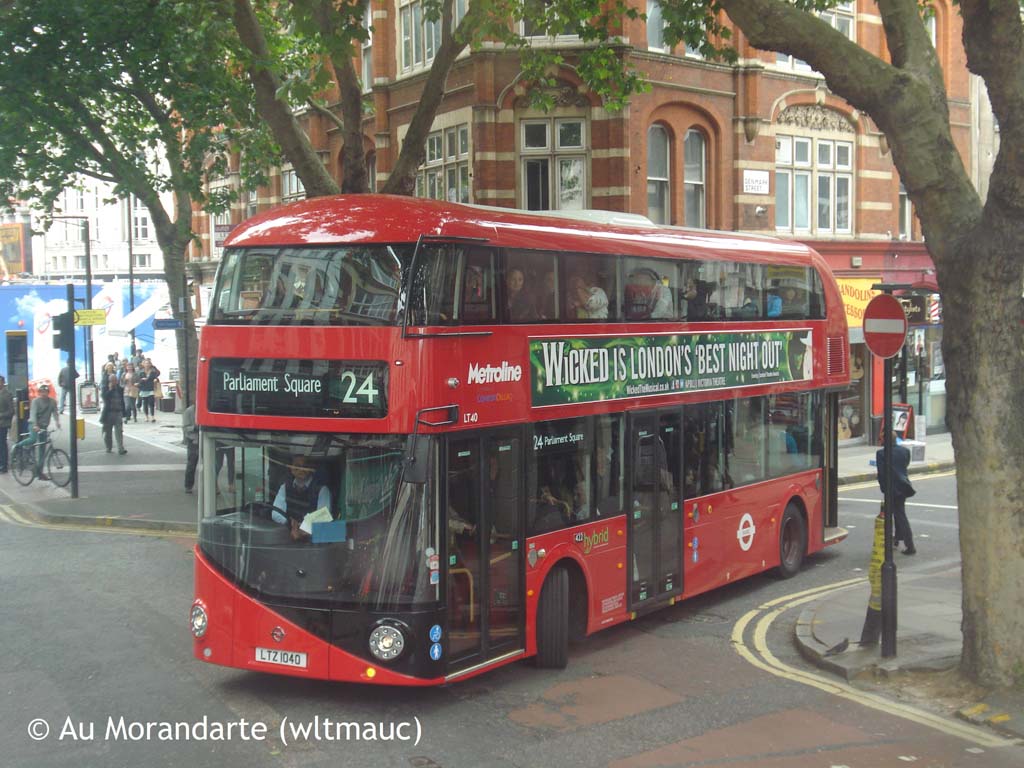 | Photo © Au Moran. |
Home | Bus routes | Operational details | Service changes | Operators & Garages | Photo gallery
In contrast to some routes which seem to change every few years the 24 is one of the most stable routes in London. It started as Hampstead Heath to Victoria on 5.5.1910, and was extended to Pimlico on 19.8.1912. It has run between the same two terminals by the same route ever since, give or take a couple of one-way systems and a slight change to the terminal working at Pimlico. Its conversion to one person operated Titans took place in the autumn of 1986, though the route had seen doored buses in previous years including fleetlines from 1976 to 1979. The Titans did not last long though, as the route was lost to Grey Green from 05/11/88, making it the first central London route to pass to the private sector, the operator's grey and green Volvo Citybuses making a striking sight running down Whitehall past Downing Street hall of power, probably not by accident.
Grey Green was the original bus operation of the Cowie group, which renamed itself Arriva in 1998. Grey Green's Stamford Hill base was subsequently closed with the allocation transferred to the expanded Tottenham garage of sister company Arriva London North (formerly Leaside). Arriva however lost the route to Metroline in November 2002, using new Volvo B7TL/Plaxton President vehicles. Requirements for new vehicles elsewhere were consolidated with an allocation of new Enviro400 double deckers on the 24 in 2005, these being the first of their type into service in London. Those buses have now moved to their originally planned home on routes 4 and 186.
Further re-tendering saw the route awarded to London General in 2007 – although it may seem odd for a south London operator to bid for a north London route, its Stockwell garage is actually no farther from the south end of the route than Holloway is from the north end, and a good deal closer than the Grey Green or Arriva base. In fact crew changes were much simpler, using the Victoria Line from Stockwell to Pimlico station (later Warren Street – with the Northern Line as a backup!), although most buses start and finish their day's work at the Hampstead Heath end, meaning they traced most of the route out of service. London General also specified Enviro400 double deckers for the 24, making this route also the first to have a second batch of that type allocated new to it.
However, Metroline triumphantly won the route back in the next re-tender and took over operation on 10 November 2012. Although the route could quite conceivably have received a third batch of new Enviro400s, Metroline instead went for the Volvo/Wright Eclipse Gemini combination, which is currently the preferred new bus type for Holloway garage; some of these were hybrids.
But the route has now once again been subjected to a high-profile change, as it was selected to be the first route for a full conversion to the "New Bus for London" ordered by Mayor Boris Johnson. The bus was originally touted as a "new Routemaster," so the choice of route 24 raised quite a few eyebrows, as the 24 was one of the earliest central London routes to lose its RMs, in 1986. One suspects that the Whitehall connection may be part of the reason – the second route, the 11, also serves this road – though this may be coincidence.
However, the 24 is actually a pragmatic choice, with much of its length within Zone 1, and with a relatively modest vehicle requirement, avoiding the need to stockpile a large number of buses whilst deliveries are still picking up momentum. Additionally, having just started a new contract means it will not be subject to upheaval for a few years, though a downside is that the brand new buses have been displaced already; a new home has been identified on route 245.
Not surprisingly, the photographers were out in force for the first journey, at 06:56 from Hampstead Heath on Saturday 22 June 2013, returning from Pimlico at 07:45. This turned out to be LT32 (LTZ 1032) driven by TfL Surface Transport MD Leon Daniels and conducted by Metroline CEO Jaspal Singh along with, as might be expected, various dignitaries including TfL Transport Commissioner Sir Peter Hendy, and much of the rest of its capacity occupied by people out to catch the first journey! It was literally an 8 man crew and the lack of the usual light Saturday morning loadings meant arrival at Pimlico was 20 minutes late. The trip was captured at Trafalgar Square.
 | Photo © Au Moran. |
As can be observed, the class has been designated LT by TfL (this does not "stand for" anything, officially anyway) and will have a common numbering sequence, the buses being owned by TfL rather than owned or leased by the operators. Bespoke registrations are the order of the day, as TfL has managed to arrange with the relevant authorities the early release of the LTZ Northern Irish sequence for the buses, with the added bonus that these can be the first registration-matched buses since the cessation of numeric registrations in 2001! With 600 buses planned, this is set to be the longest continuous registration sequence since the WLT*** marks on RMs.
A more routine shot is of a well-laden LT40 (LTZ 1040) turning out of Denmark Street (near Tottenham Court Road Station) later on the same day on a short working to Parliament Square, viewed from the front of another LT. The extended length of these vehicles, required to accommodate a second staircase, is evident in this view, and the open platform can also be seen.
 | Photo © Au Moran. |
The first day of service was badly disrupted because of the planned closure of the Northern Line, not helped by road works in Victoria Street and inevitable teething problems and unfamiliarity of passengers and crews with the new stock. Within a few weeks however things seem to have settled down well, with the only major complaint being faults with the air cooling system. The buses have no opening windows as these reduce the effectiveness of the air cooling – this is standard on trains, but a novel feature on buses – a good idea in principle, but not if the air cooling is unreliable.
For all the talk of a "new Routemaster," the new bus really has much more in common with other modern double deckers than with the real Routemaster. Aside from the rear platform and staircase and a curvier-than-usual roof, the rest is the bog standard layout other buses have. A low floor and hybrid drivetrain were inevitable, but the other good features of the RM have not been incorporated. The engine is at the back, as usual, albeit under the stairs, replaced at the front by a normal front entrance, to allow the bus to operate without a conductor in the evenings and at night. There is also still a centre door, primarily to allow wheelchair access. Given these features, a twin staircase layout was perhaps inevitable, but means a longer bus which in turn increases its weight and reduces the number of passengers that can legally be carried (though at 80 this is still slightly higher than the long Routemaster at 77). The conductor's role is largely to prevent accidents on the platform – he does not collect fares, leaving that task to the driver, thereby removing one of the main speed benefits of the original RM – as do the doors fitted to the other entrances. In fairness, most passengers these days use Oyster cards, and readers are provided at each entrance.
Still, it is good to see moves to drive vehicle design forward instead of just accepting what has been the norm for over 40 years, and hopefully the new bus will prove to be the icon that some have already prematurely described it as!
Navigation
| Previous | Next | |
| Chronologically | 211 | 230 |
| Numerically | 23 | 25 |
Photo Gallery | Bus route list | Operational details | Service changes | Operators & Garages